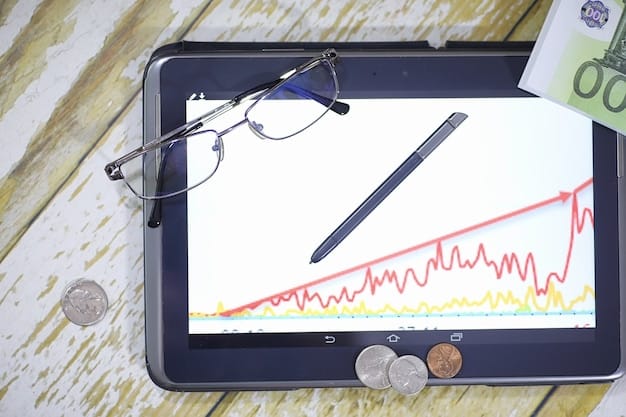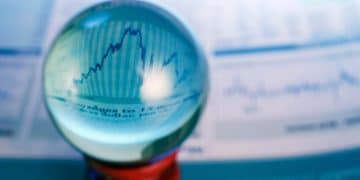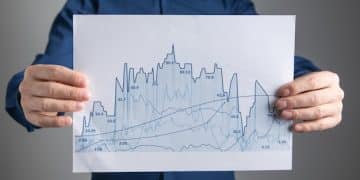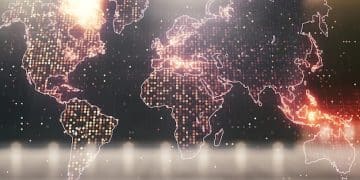US Economic Forecast: Experts Predict 2.5% GDP Growth in 2025

Experts predict a 2.5% GDP growth for the US in 2025, signaling moderate economic expansion; this forecast impacts business planning, investment strategies, and consumer behavior across various sectors.
The latest economic forecast projects a 2.5% GDP growth for the US in 2025. What does this mean for your business? Let’s dive into the implications and strategic planning.
Understanding the 2025 GDP Growth Forecast
The projected 2.5% GDP growth for the US in 2025 is a crucial indicator for businesses. Understanding this figure and its underlying factors is vital for effective planning and decision-making. This section will break down the components of GDP and provide insights into how this growth rate is determined.
What is GDP and How is it Measured?
Gross Domestic Product (GDP) is the total monetary or market value of all the finished goods and services produced within a country’s borders in a specific time period. It’s a comprehensive scorecard of a country’s economic health.
GDP is typically measured using the expenditure approach, which sums up:
- Consumption (C): Spending by households on goods and services.
- Investment (I): Spending by businesses on capital goods, inventories, and structures.
- Government Spending (G): Expenditures by the government on goods and services.
- Net Exports (NX): Exports minus imports.
The formula is: GDP = C + I + G + NX
Factors Influencing the 2.5% Growth Projection
Several factors contribute to the 2.5% growth projection. These include:
- Consumer Spending: Expected to remain stable, driven by a healthy labor market.
- Business Investment: Anticipated to increase as companies invest in technology and expansion.
- Government Policies: Fiscal and monetary policies play a crucial role in influencing economic growth.
In conclusion, the 2.5% GDP growth forecast is a balanced projection considering various economic drivers and potential challenges. Businesses should closely monitor these factors to adapt their strategies accordingly.

Impact on Key Business Sectors
The 2.5% GDP growth will have varying effects on different business sectors. Analyzing these impacts can help businesses identify opportunities and mitigate risks. Let’s explore how specific sectors are likely to be affected.
Technology Sector
The technology sector is expected to benefit significantly from the projected GDP growth. Increased business investment in technology and digital transformation initiatives will drive demand for tech products and services.
Growth drivers include:
- Investments in Artificial Intelligence (AI) and Machine Learning (ML).
- Adoption of cloud computing and cybersecurity solutions.
- Increased demand for software and IT services.
Healthcare Sector
The healthcare sector is generally recession-resistant but will still experience impacts from GDP growth. Increased consumer spending and government investment in healthcare will drive growth.
- Aging population driving demand for healthcare services.
- Innovation in pharmaceuticals and medical technology.
- Government initiatives to expand healthcare access.
Manufacturing Sector
The manufacturing sector may see moderate growth due to increased business investment and consumer demand for durable goods. However, global trade dynamics and supply chain issues could pose challenges.
In closing, the projected 2.5% GDP growth will create opportunities and challenges for various sectors. Businesses need to understand these dynamics to make informed decisions.
Strategic Planning for Businesses
With a 2.5% GDP growth on the horizon, strategic planning is more important than ever. Businesses must adjust their strategies to capitalize on opportunities and mitigate potential risks. Let’s explore some key planning considerations.
Investment Strategies
Businesses should consider these investment strategies:
- Prioritize investments in technology and digital transformation.
- Expand into growth markets and diversify product offerings.
- Focus on efficiency and cost optimization.
Risk Management
Effective risk management is crucial in an evolving economic landscape:
- Identify and assess potential risks, such as inflation and supply chain disruptions.
- Develop contingency plans and diversify supply chains.
- Implement robust financial management practices.
Workforce and Talent Management
Attracting and retaining top talent is essential for sustainable growth:
In summary, strategic planning should be comprehensive and forward-looking. Businesses that adapt effectively to the changing economic environment will be best positioned for success.

Consumer Behavior and Spending Patterns
The 2.5% GDP growth will influence consumer behavior and spending patterns. Understanding these shifts is critical for businesses that rely on consumer demand. This section explores how consumers are likely to respond.
Impact of Inflation
Inflation can erode purchasing power if wage growth does not keep pace. Businesses need to monitor inflation and adjust pricing strategies accordingly. Consumers may:
In general, understanding consumer behavior is essential for businesses. Adaptability and responsiveness to changing consumer needs will be key to success.
Potential Challenges and Uncertainties
While the 2.5% GDP growth offers optimism, it’s essential to acknowledge potential challenges and uncertainties that could impact economic performance. This section will discuss some key risks.
Geopolitical Risks
Adapting to evolving workforce dynamics will be key to maximizing the benefits of economic growth.
Businesses need to be prepared for shifts in consumer behavior.
Businesses need to be aware of these risks and develop strategies to mitigate their impact.
The 2.5% GDP growth is subject to various geopolitical factors, including trade tensions and international conflicts. These events can disrupt supply chains, increase costs, and dampen economic activity. Businesses should:
Supply Chain Disruptions
Supply chain disruptions remain a concern. Businesses need to diversify their supply chains and build resilience. Strategies include:
- Prioritize ethical sourcing and sustainability.
Monetary Policy and Interest Rates
Changes in monetary policy and interest rates can influence borrowing costs and investment decisions. Businesses should:
Navigating the Economic Landscape
To effectively navigate the economic landscape in 2025, businesses should take a proactive approach. This involves continuous monitoring, adaptable strategies, and a focus on long-term sustainability. Let’s outline some actionable steps.
Continuous Monitoring
Businesses should continuously monitor economic indicators, industry trends, and consumer behavior. This includes:
- Conducting market research to understand consumer preferences.
Adaptable Strategies
Flexibility is key. Businesses should be prepared to adjust their strategies based on changing conditions. This involves:
In summation, navigating the economic landscape requires vigilance and adaptability. Businesses that stay informed and proactive will be better equipped to thrive in 2025 and beyond.
US Economic Growth: Key Takeaways
What will it take?
How will various sectors fare?
How can business strategize effectively?
Key Point
Brief Description
Forecast Overview
Experts project 2.5% GDP growth, indicating moderate expansion.
Business Impact
Tech, healthcare, and manufacturing to be affected differently.
Planning Strategies
Focus on innovation, risk management, and workforce flexibility.
What does the 2.5% GDP growth forecast mean for the average American?
A 2.5% GDP growth typically translates to more job opportunities, stable wages, and increased consumer spending, benefiting the average American through economic stability.
How can small businesses leverage this economic forecast?
Small businesses can leverage this forecast by investing in technology, optimizing operations, and focusing on customer retention to capitalize on increased consumer spending.
What are the potential risks that could derail the 2.5% GDP growth?
Geopolitical tensions, supply chain disruptions, and shifts in monetary policy are potential risks that could impact the forecasted 2.5% GDP growth, warranting close monitoring.
Which sectors are expected to see the most growth in 2025?
The technology and healthcare sectors are projected to experience the most growth in 2025, driven by innovation, digital transformation, and increased demand for services.
What role does government policy play in achieving this GDP growth?
Government policies, including fiscal spending and monetary measures, play a crucial role in fostering economic stability and encouraging investment, directly influencing the GDP growth rate.
The 2.5% GDP growth forecast for the US in 2025 presents both opportunities and challenges for businesses. Strategic planning, continuous monitoring, and adaptability are essential for navigating the economic landscape and achieving sustainable growth.
Read more content





